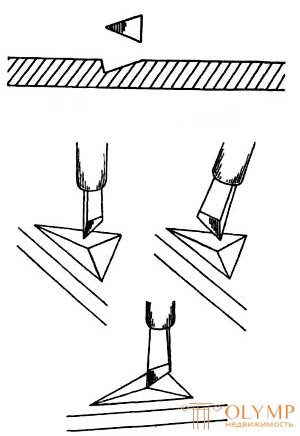
Geometric, or trihedral-grooved carving (another name is found in the literature - wedge-shaped) consists of a number of alphabet patterns, the combination of which gives beautiful, expressive compositions. Contour threads can sometimes be referred to varieties of geometric threads, if it has straight or circular outlines.
All variety of patterns of a geometrical carving consists of a combination of two alphabet elements - a pin and a triangle, which can be in any compositions. Any, the most complex geometric pattern can be divided into its constituent elements, and they will be either shreds (Fig. 1) or triangles (Fig. 2).
 | 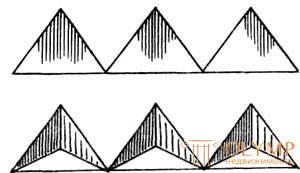 |
| Fig. 1-2. The execution of the element "puff" and "triangle" | Fig. 3. Triangles - the basis of classic compositions of Russian masters |
In search of a composition for such patterns, it is necessary to turn to classical works of folk art. For Russia, patterns characterized mainly from triangles are more characteristic (Fig. 3). These patterns always have a pronounced central composition. Geometric carving Komi prefers chips. The peoples of the Caucasus are dominated by large expressive elements of the thread, but the Carpathian region (Ukraine) prefers the finest and complex compositions in the thread. It is the triangles and shambles, merging into diamonds, chains, voteiki, etc., that give an endless variety of compositions. Now about the tool with which all this is done. This is a good, reliable knife. But not quite normal. You will need a scythe, or a shoe knife. The knife should be strong, firmly seated in the hand and very sharply honed. The simplest, but reliable knife can be made from an ordinary flat chisel 20-30 mm wide. For this you can use an emery wheel. When performing a geometrical thread, the knife must be held tightly in a fist, resting its left thumb on the handle of the knife (Fig. 4). Fingers of the other hand should direct the tip of the knife, setting it on the line of the picture.
In cases where the furniture has already been threaded and it is damaged (chipped, cracked, etc.), you can take steps to restore it. Chips close up, sticking on a pre-leveled surface a piece of wood of the same breed and with the same direction of fibers, which is then given the desired shape. Cracks, breaks, dents close up putty or inserts of the same type of wood.
The simplest case is the invoice thread. First, carefully measure and draw an existing element, similar or symmetrical to the lost one. Then make a pattern, repeating the contour of the thread in the plan. You can also mold the relief of clay, to better feel its shape. Make a harvest from healthy wood without knots (in this case linden)
humidity not higher than 8%. The dimensions of the workpiece must somewhat exceed the dimensions of the part. It should be carefully cut, then sawn along the contour with a small allowance.
The workpiece is glued with glue to a flat baseboard or shield, laying a thin bugmagu, and the thread pattern is transferred to the workpiece. They cut and cut the contours of the petals with semicircular chisels of different curvatures, then work on the relief (at first coarse then thinly) and sand it with a sandpaper. The finished thread is removed and cleaned of paper, then the thread is trimmed and then glued onto the finished surface of the back of the chair.
When restoring volume carved elements or parts, such as a carved leg, they are measured and a blank template is made.
A template of thin plywood or thick cardboard should have an allowance for the final surface treatment of the part. It imposes on the prepared bar and delineate. The workpiece is cut with a band saw or a saw,
After that, the chisel tools (chisels, knives, rasps) bring the workpiece to the required shape, constantly controlling the dimensions at the most characteristic points of the original. When the required shape is obtained, attach a pre-cut piece, forming a console. You can simply glue it on a smooth cut, but it is better to strengthen the connection with dowels.
Sometimes they help the movement of the knife with pressure, sometimes they restrain it. The earring is the simplest element, and it is also cut very simply: the knife is buried near one of the vertices (on the sides of the triangle), and at the opposite base comes to the surface. Then, starting from this base, the wood is cut over the entire area of the triangle, again deepening at the top.
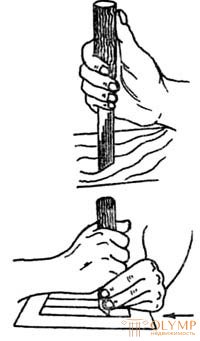 | 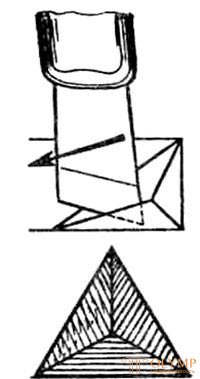 |  |
| Fig. 4. The position of the hands when performing elements of geometric thread | Fig. 5. Making triangular grooved thread | Fig. 6. Patterns in geometric thread: a - ladder; b - diamonds; in - a snake; g - shine; e - scoli |
The process of cutting a geometric triangle is as follows: the knife tip is deepened to the point where the three angular rays of the triangle are reduced, so that at this point the knife goes deeper and its blade reaches the surface near the top. This stage is called tattoos. Patch on all beams. Then, without changing the position of the knife in the fist, just tilting the hand to the right or left and turning the plate on the plane for ease of cutting, trimming the impaled elements along the lines of the sides of the triangles (Fig. 5). Moreover, the blade of the knife most deeply enters the tree at the central point of convergence of the rays and gradually comes to the surface near the peaks. Trihedral figures are extracted from the surface of the tree (hence the name of the thread - trihedral-notched).
In this sequence, all the triangles that make up the composition of the geometric thread (Fig. 6) are performed. A product with a geometric thread can be tinted in gray using watercolor or liquid black ink. After drying the surface (natural drying for about a day), it is polished to a light wood. Dark gray geometric patterns on a light wood background are very expressive. Gray color can have a wide color gradation from gray-ocher to cold gray-blue. After polishing the tinted surface, it is possible to lightly (single-layer) coat it with a liquid diluted varnish.
You can make the thread in a negative version - pre-toned product prepared under the thread in a dark (but not black) color, such as gray, brown. Letting it dry and cutting patterns on this background Light, juicy patterns on a dark background create an expressive decorative effect.
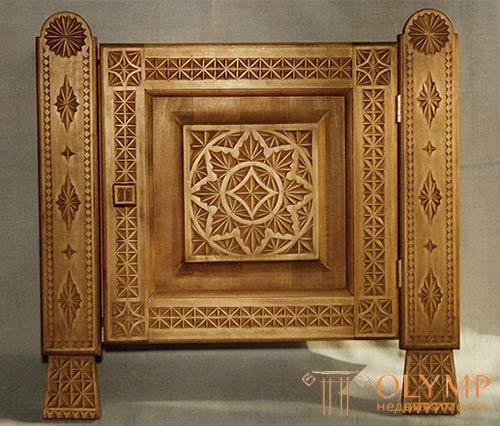
Что бы оставить комментарий войдите
Комментарии (0)